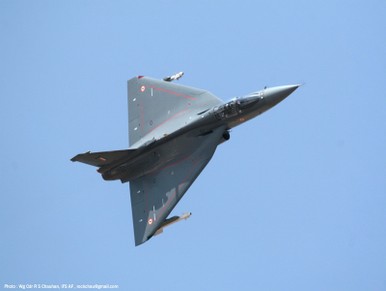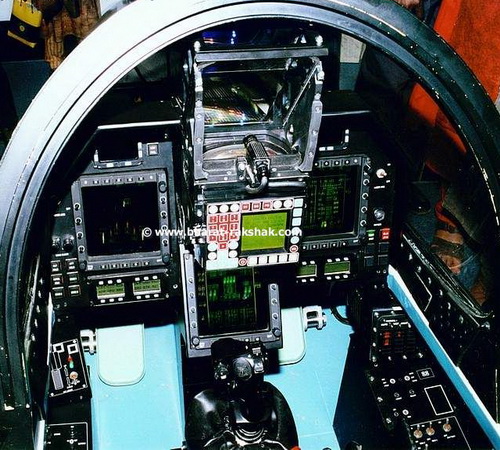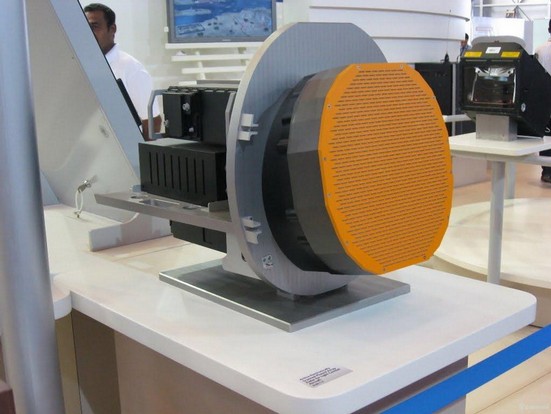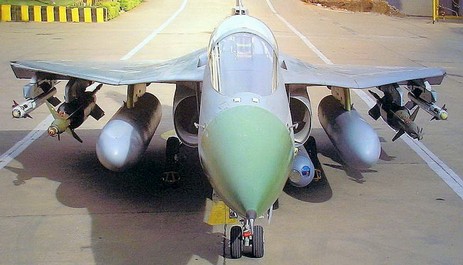HAL- LCA-Tejas
 The HAL Tejas (Sanskrit: "Radiant") is a lightweight multirole jet fighter developed by India. It is a tailless, compound delta wing design powered by a single engine. It came from the Light Combat Aircraft (LCA) programme, which was begun in the 1980s to replace India's ageing MiG-21 fighters. Later the LCA was officially named "Tejas" by then Prime Minister Atal Bihari Vajpayee.
The HAL Tejas (Sanskrit: "Radiant") is a lightweight multirole jet fighter developed by India. It is a tailless, compound delta wing design powered by a single engine. It came from the Light Combat Aircraft (LCA) programme, which was begun in the 1980s to replace India's ageing MiG-21 fighters. Later the LCA was officially named "Tejas" by then Prime Minister Atal Bihari Vajpayee.
The Tejas has the delta wing configuration, with no tailplanes or foreplanes, features a single vertical fin. It integrates technologies such as relaxed static stability, fly-by-wire flight control system, advanced digital cockpit, multi-mode radar, integrated digital avionics system, advanced composite material structures and a flat rated engine.
The IAF is reported to have a requirement for 200 single-seat and 20 two-seat conversion trainers, while the Indian Navy may order up to 40 single-seaters to replace its Sea Harrier FRS.51 and Harrier T.60. During its sea level flight trials off Goa, Tejas notched a speed of over 1,350 km per hour, thus becoming the second supersonic fighter manufactured indigenously by Hindustan Aeronautics Limited after the HAL Marut. The Tejas received Initial Operating Clearance (IOC) in January 2011.
Development
LCA programme
In 1969, the Indian government accepted the recommendation by its Aeronautics Committee that Hindustan Aeronautics Limited (HAL) should design and develop an advanced technology fighter aircraft around a proven engine. Based on a 'Tactical Air Support Aircraft' ASR markedly similar to that for the Marut, HAL completed design studies in 1975, but the project fell through due to inability to procure the selected "proven engine" from a foreign manufacturer and the IAF's requirement for an air superiority fighter with secondary air support and interdiction capability remained unfulfilled.
The LCA programme was launched in 1983 for two primary purposes. The principal and most obvious goal was the development of a replacement aircraft for India's ageing MiG-21 fighters. The MiG-21 has been the mainstay of the Indian Air Force since the 1970s. The "Long Term Re-Equipment Plan 1981" noted that the MiG-21s would be approaching the end of their service lives by the mid-1990s, and that by 1995 the IAF would lack 40% of the aircraft needed to fill its projected force structure requirements.
The LCA programme's other main objective was to serve as the vehicle for an across-the-board advancement of India's domestic aerospace industry. The value of the aerospace "self-reliance" initiative is not simply the production of an aircraft, but also the building of a local industry capable of creating state-of-the-art products with commercial spin-offs for a global market. The LCA program was intended in part to further expand and advance India's indigenous aerospace capabilities.
Design
The Tejas is single-engined multirole fighter which features a tailless, compound delta-wing planform and is designed with "relaxed static stability" for enhanced maneuverability. Originally intended to serve as an air superiority aircraft with a secondary "dumb bomb" ground-attack role, the flexibility of this design approach has permitted a variety of guided air-to-surface and anti-shipping weapons to be integrated for more well-rounded multirole and multimission capabilities.
The tailless, compound-delta planform is designed to keep the Tejas small and lightweight. The use of this planform also minimises the control surfaces needed (no tailplanes or foreplanes, just a single vertical tailfin), permits carriage of a wider range of external stores, and confers better close-combat, high-speed, and high-alpha performance characteristics than comparable cruciform-wing designs. Extensive wind tunnel testing on scale models and complex computational fluid dynamics analyses have optimised the aerodynamic configuration of the LCA, giving it minimum supersonic drag, a low wing-loading, and high rates of roll and pitch.
All weapons are carried on one or more of seven hardpoints with total capacity of greater than 4,000 kg: three stations under each wing and one on the under-fuselage centreline. There is also an eighth, offset station beneath the port-side intake trunk which can carry a variety of pods (FLIR, IRST, laser rangefinder/designator, or reconnaissance), as can the centreline under-fuselage station and inboard pairs of wing stations.
The Tejas has integral internal fuel tanks to carry 3,000 kg of fuel in the fuselage and wing, and a fixed inflight refuelling probe on the starboard side of the forward fuselage. Externally, there are "wet" hardpoint provisions for up to three 1,200- or five 800-litre (320- or 210-US gallon; 260- or 180-Imp gallon) fuel tanks on the inboard and mid-board wing stations and the centreline fuselage station.
Airframe
The LCA is constructed of aluminium-lithium alloys, carbon-fibre composites (C-FC), and titanium-alloy steels. The Tejas employs C-FC materials for up to 45% of its airframe by weight, including in the fuselage (doors and skins), wings (skin, spars and ribs), elevons, tailfin, rudder, air brakes and landing gear doors. Composites are used to make an aircraft both lighter and stronger at the same time compared to an all-metal design, and the LCA's percentage employment of C-FCs is one of the highest among contemporary aircraft of its class. Apart from making the plane much lighter, there are also fewer joints or rivets, which increases the aircraft's reliability and lowers its susceptibility to structural fatigue cracks.
The tailfin for the LCA is a monolithic honeycomb piece, an approach which reduced its manufacturing cost by 80% compared to the customary "subtractive" or "deductive" method, whereby the shaft is carved out of a block of titanium alloy by a computerized numerically controlled machine. No other manufacturer is known to have made fins out of a single piece. A 'nose' for the rudder is added by 'squeeze' riveting.
The use of composites in the LCA resulted in a 40% reduction in the total number of parts compared to using a metallic frame. Furthermore, the number of fasteners has been reduced by half in the composite structure from the 10,000 that would have been required in a metallic frame design. The composite design also helped to avoid about 2,000 holes being drilled into the airframe. Overall, the aircraft's weight is lowered by 21%. While each of these factors can reduce production costs, an additional benefit - and significant cost savings - is realised in the shorter time required to assemble the aircraft - seven months for the LCA as opposed to 11 months using an all-metal airframe.
The airframe of the naval variant of the Tejas will be modified with a nose droop to provide improved view during landing approach, and wing leading edge vortex controllers (LEVCON) to increase lift during approach. The LEVCONs are control surfaces that extend from the wing-root leading edge and thus afford better low-speed handling for the LCA, which would otherwise be slightly hampered due to the increased drag that results from its delta-wing design. As an added benefit, the LEVCONs will also increase controllability at high angles of attack (AoA).
The naval Tejas will also have a strengthened spine, a longer and stronger undercarriage, and powered nose wheel steering for deck manoeuvrability. The Tejas trainer variant will have "aerodynamic commonality" with the two-seat naval aircraft design.
Landing gear
The Tejas has a hydraulically retractable tricycle-type landing gear with a pair of single inward-retracting mainwheels and a steerable, twin-wheel forward-retracting nose gear. The landing gear was originally to have been imported, but following the imposition of trade sanctions, HAL developed the entire system independently.
India's Nuclear Fuel Complex (NFC) led the team that developed the titanium half-alloy tubes that are used for hydraulic power transmission and they are critical components in the LCA.This technology also has space applications.
Flight controls Since the Tejas is a relaxed static stability design, it is equipped with a quadruplex digital fly-by-wire flight control system to ease handling by the pilot. The Tejas' aerodynamic configuration is based on a pure delta-wing layout with shoulder-mounted wings. Its control surfaces are all hydraulically actuated. The wing's outer leading edge incorporates three-section slats, while the inboard sections have additional slats to generate vortex lift over the inner wing and high-energy air-flow along the tail fin to enhance high-AoA stability and prevent departure from controlled flight. The wing trailing edge is occupied by two-segment elevons to provide pitch and yaw control. The only empennage-mounted control surfaces are the single-piece rudder and two airbrakes located in the upper rear part of the fuselage, one each on either side of the fin.
Since the Tejas is a relaxed static stability design, it is equipped with a quadruplex digital fly-by-wire flight control system to ease handling by the pilot. The Tejas' aerodynamic configuration is based on a pure delta-wing layout with shoulder-mounted wings. Its control surfaces are all hydraulically actuated. The wing's outer leading edge incorporates three-section slats, while the inboard sections have additional slats to generate vortex lift over the inner wing and high-energy air-flow along the tail fin to enhance high-AoA stability and prevent departure from controlled flight. The wing trailing edge is occupied by two-segment elevons to provide pitch and yaw control. The only empennage-mounted control surfaces are the single-piece rudder and two airbrakes located in the upper rear part of the fuselage, one each on either side of the fin.
The digital FBW system of the Tejas employs a powerful digital flight control computer (DFCC) comprising four computing channels, each with its own independent power supply and all housed in a single LRU. The DFCC receives signals from a variety of sensors and pilot control stick inputs, and processes these through the appropriate channels to excite and control the elevons, rudder and leading edge slat hydraulic actuators. The DFCC channels are built around 32-bit microprocessors and use a subset of the Ada programming language for software implementation. The computer interfaces with pilot display elements like the MFDs through MIL-STD-1553B multiplex avionics data buses and RS-422 serial links.
Propulsion
The wing-shielded, side-mounted bifurcated, fixed-geometry Y-duct air intakes have an optimised diverter configuration to ensure buzz-free air supply to the engine at acceptable distortion levels, even at high AoA.
The original plan was for the LCA prototype aircraft to be equipped with the General Electric F404-GE-F2J3 afterburning turbofan engine, while the production aircraft would be fitted with the indigenous GTRE GTX-35VS Kaveri turbofan being developed in a parallel. Continued development snags with the Kaveri resulted in a 2003 decision to procure the uprated GE F404-IN20 engine for the eight pre-production LSP aircraft and two naval prototypes and after accelerated trials an order was placed for 24 more IN20 engines for installation on the first 20 production aircraft. The Tejas Mark II will be equipped with the GE F414 engine.
Avionics
The Tejas has a night vision goggles (NVG)-compatible "glass cockpit" that is dominated by an indigenous head-up display (HUD), three 5 in x 5 in multi-function displays, two Smart Standby Display Units (SSDU), and a "get-you-home" panel (providing the pilot with essential flight information in case of an emergency). The CSIO-developed HUD, Elbit-furnished DASH helmet-mounted display and sight (HMDS), and hands-on-throttle-and-stick (HOTAS) controls reduce pilot workload and increase situation awareness by allowing the pilot to access navigation and weapon-aiming information with minimal need to spend time "head down" in the cockpit.
The MFDs provide information on the engine, hydraulics, electrical, flight control, and environmental control systems on a need-to-know basis, along with basic flight and tactical information. Dual redundant display processors produce computer-generated imagery on these displays. The pilot interacts with the complex avionics systems through a simple multifunction keyboard and function and sensor selection panels.
Target acquisition is accomplished through a state-of-the-art radar - potentially supplemented by a laser designator pod, forward-looking infra-red (FLIR) or other opto-electronic sensors - to provide accurate target information to enhance kill probabilities. A ring laser gyro (RLG)-based inertial navigation system (INS) provides accurate navigation guidance to the pilot. The LCA also has secure and jam-resistant communication systems such as theIFF transponder/interrogator, VHF/UHF radios, and air-to-air/air-to-ground datalinks. The ADA Systems Directorate's Integrated Digital Avionics Suite (IDAS) integrates the flight controls, environmental controls, aircraft utilities systems management, stores management system (SMS), etc. on three 1553B buses by a centralised 32-bit, high-throughput mission computer.
Radar The coherent pulse-Doppler Multi-Mode Radar in development is designed to keep track of a maximum of 10 targets and allowing simultaneous multiple-target engagement. Jointly developed by the LRDE and HAL Hyderabad, the MMR is being designed to perform multi-target search, track-while-scan (TWS), and ground-mapping functions. It features look-up/look-down modes, low-/medium-/high-pulse repetition frequencies (PRF), platform motion compensation, doppler beam-sharpening, moving target indication (MTI), Doppler filtering, constant false-alarm rate (CFAR) detection, range-Doppler ambiguity resolution, scan conversion, and online diagnostics to identify faulty processor modules. While originally planned to be fitted on production aircraft, delays in the development of MMR prompted the DRDO to co-operate with Israel Aerospace Industries to integrate a Hybrid version of the EL/M-2032 radar for use with Tejas. The EL/M-2032 radar used in LSP-3 has a detection and tracking range of up to 150 km in air-to-air mode, the air-to-ground mode generates high resolution radar imagery of locations at up to 150 km, and air-to-sea mode can detect and classify naval targets at ranges of up to 300 km.
The coherent pulse-Doppler Multi-Mode Radar in development is designed to keep track of a maximum of 10 targets and allowing simultaneous multiple-target engagement. Jointly developed by the LRDE and HAL Hyderabad, the MMR is being designed to perform multi-target search, track-while-scan (TWS), and ground-mapping functions. It features look-up/look-down modes, low-/medium-/high-pulse repetition frequencies (PRF), platform motion compensation, doppler beam-sharpening, moving target indication (MTI), Doppler filtering, constant false-alarm rate (CFAR) detection, range-Doppler ambiguity resolution, scan conversion, and online diagnostics to identify faulty processor modules. While originally planned to be fitted on production aircraft, delays in the development of MMR prompted the DRDO to co-operate with Israel Aerospace Industries to integrate a Hybrid version of the EL/M-2032 radar for use with Tejas. The EL/M-2032 radar used in LSP-3 has a detection and tracking range of up to 150 km in air-to-air mode, the air-to-ground mode generates high resolution radar imagery of locations at up to 150 km, and air-to-sea mode can detect and classify naval targets at ranges of up to 300 km.
The development of an AESA radar for the Tejas is expected to begin pending the selection of an developmental partner.The contenders for the contract are the European Consortium EADS and the Israeli company Elta.The initial contract will see the co-development of 10 prototypes.
Self-protection
The electronic warfare suite is designed to enhance the Tejas' survivability during deep penetration and combat. The LCA's EW suite is developed by the Defence Avionics Research Establishment (DARE) with support from the Defence Electronics Research Laboratory (DLRL).[16] This EW suite, known as "Mayavi"(Illusionist), includes a radar warning receiver (RWR), self-protection jammer, laser warning system, missile approach warning system, and chaff/flare dispenser. In the interim, the Indian Defence Ministry has revealed that an unspecified number of EW suites had been purchased from Israel's Elisra for the LCA prototypes.
The ADA claims that a degree of "stealth" has been designed into the Tejas. Being very small, there is an inherent degree of "visual stealth", but the airframe's use of a high degree of composites (which do not reflect radar waves), a Y-duct inlet which shields the engine compressor face from probing radar waves, and the application of radar-absorbent material (RAM) coatings are intended to minimise its susceptibility to detection and tracking by the radars of enemy fighters, airborne early warning and control (AEW&C) aircraft, active-radar air-to-air missiles (AAM), and surface-to-air missile (SAM) defence systems.
Escape systems
Although two-seat variants of the LCA are planned, the examples built to date are crewed by a single pilot on a Martin-Baker zero-zero ejection seat. The British Martin-Baker ejection seat is planned to be replaced with a locally-developed alternative. To improve pilot safety during ejection, the Armament Research and Development Establishment (ARDE), Pune, India created a new line-charged canopy.
Variants
Prototypes
Aircraft already built and projected models to be built. Model designations, tail numbers and dates of first flight are shown.
Technology Demonstrators (TD)
TD-1 (KH2001) - 4 Jan 2001
TD-2 (KH2002) - 6 June 2002
Prototype Vehicles (PV)
PV-1 (KH2003) - 25 November 2003
PV-2 (KH2004) - 1 December 2005
PV-3 (KH2005) - 1 December 2006 - This is the production variant.
PV-4 - Originally planned to be a Naval variant for carrier operations, but now a second production variant.
PV-5 (KH-T2009) - 26 November 2009 - Fighter/Trainer Variant
Naval Prototypes (NP)
 NP-1 - Two-seat Naval variant for carrier operations.Rolled out in July 2010.
NP-1 - Two-seat Naval variant for carrier operations.Rolled out in July 2010.
NP-2 - Single-seat Naval variant for carrier operations.
Limited Series Production (LSP) aircraft
Currently, 28 LSP series aircraft plus 20 aircraft are on order.
LSP-1 (KH2011) - 25 April 2007
LSP-2 (KH2012) - 16 June 2008. This is the first LCA fitted with GE-404 IN20 engine.
LSP-3 23 April 2010. The first aircraft to have the Hybrid MMR radar and will be close to the IOC standard.
LSP-4 (KH2014) - 2 June 2010 The first aircraft that was flown in the configuration that will be delivered to the Indian Air Force In addition to the Hybrid MMR, the aircraft flew with a Countermeasure Dispensing System, and an identify friend or foe electronic system.
LSP-5 (KH2015) - 19 November 2010 IOC standard with all sensor including night lighting in the cockpit, and an auto-pilot.
LSP-6 - Will be used to increase the Angle of Attack.
LSP-7 to LSP-8 - Will be given to IAF for user trials.
SP-1 to SP-40 - Planned to fly by late 2013.
Planned production variants
Tejas Trainer - Two-seat operational conversion trainer for the Indian Air Force.
Tejas Navy - Twin- and single-seat carrier-capable variants for the Indian Navy. The LCA's naval variant is to be ready for carrier trials by 2013 and is slated for deployment on the INS Vikramaditya as well as the Vikrant class aircraft carrier. It will be equipped for carrier operation with ski-jump take-off and arrested landing. It will include strengthened airframe and landing gear and the nose is drooped for better cockpit vision.
Tejas Mark 2 - Featuring more powerful engine and refined aerodynamics. The Mark 2 is being developed to meet the Indian Air Staff requirements.
Operators
India
Indian Air Force
Indian Navy- Signed an order for six Naval LCAs at an approximate cost of US$31.09 million per aircraft.
Specifications (HAL Tejas)
General characteristics
Crew: 1
Length: 13.20 m (43 ft 4 in)
Wingspan: 8.20 m (26 ft 11 in)
Height: 4.40 m (14 ft 9 in)
Wing area: 38.4 m² (413 ft²)
Empty weight: 5,680kg (12,522 lb)
Loaded weight: 9,500 kg (20,945 lb)
Max takeoff weight: 13,500 kg (31,967 lb)
Powerplant: 1× General Electric F404-GE-IN20 turbofan
Dry thrust: 53.9 kN (11,250 lbf)
Thrust with afterburner: 85 kN (19,000 lbf)
Internal fuel capacity: 3000 liters
External fuel capacity: 5×800 liter tanks or 3×1,200 liter tanks, totaling 4,000/3,600 liters
Performance
Maximum speed: Mach 1.8 (2,376+ km/h at high altitude) at 15,000 m
Range: 3000 km (1,840 mi (without refueling))
Service ceiling: 16,500 m (54,000 ft (engine re-igniter safely capable))
Wing loading: 221.4 kg/m² (45.35 lb/ft²)
Thrust/weight: .91
Armament
Guns: 1× mounted 23 mm twin-barrel GSh-23 cannon with 220 rounds of ammunition.
Hardpoints: 8 total: 1× beneath the port-side intake trunk, 6× under-wing, and 1× under-fuselage with a capacity of >4000 kg external fuel and ordnance
Missiles:
Air-to-air missiles:
Python 5
Derby
Astra BVRAAM
Vympel R-77 (NATO reporting name: AA-12 Adder)
Vympel R-73 (NATO reporting name: AA-11 Archer)
Air-to-surface missiles:
Kh-59ME TV guided standoff Missile
Kh-59MK Laser guided standoff Missile
Anti-ship missile
Kh-35
Kh-31
Bombs:
KAB-1500L laser guided bombs
FAB-500T dumb bombs
OFAB-250-270 dumb bombs
OFAB-100-120 dumb bombs
RBK-500 cluster bombs
Others:
Drop tanks for ferry flight/extended range/loitering time.
LITENING targeting pod
Avionics
Hybrid MMR radar (Israeli EL/M-2032 back end processor with Indian inputs)

